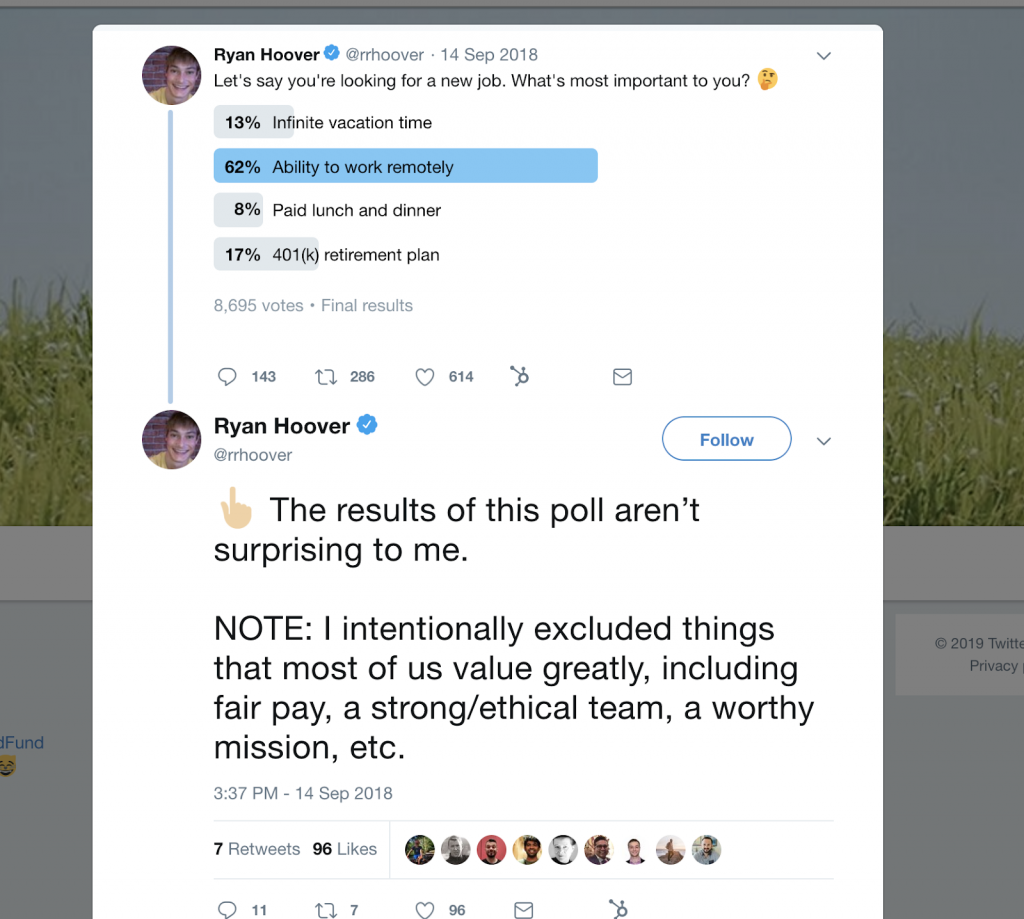Remote work is the way of the future.
As a remote worker myself, I may be a bit biased. Still, objectively, the world seems to be moving in that direction – at the very least, flexible and distributed working arrangements seem to be more and more common.
For instance, telecommuting among the non-self-employed population has grown by 140% since 2005. Employees want the option to do so.
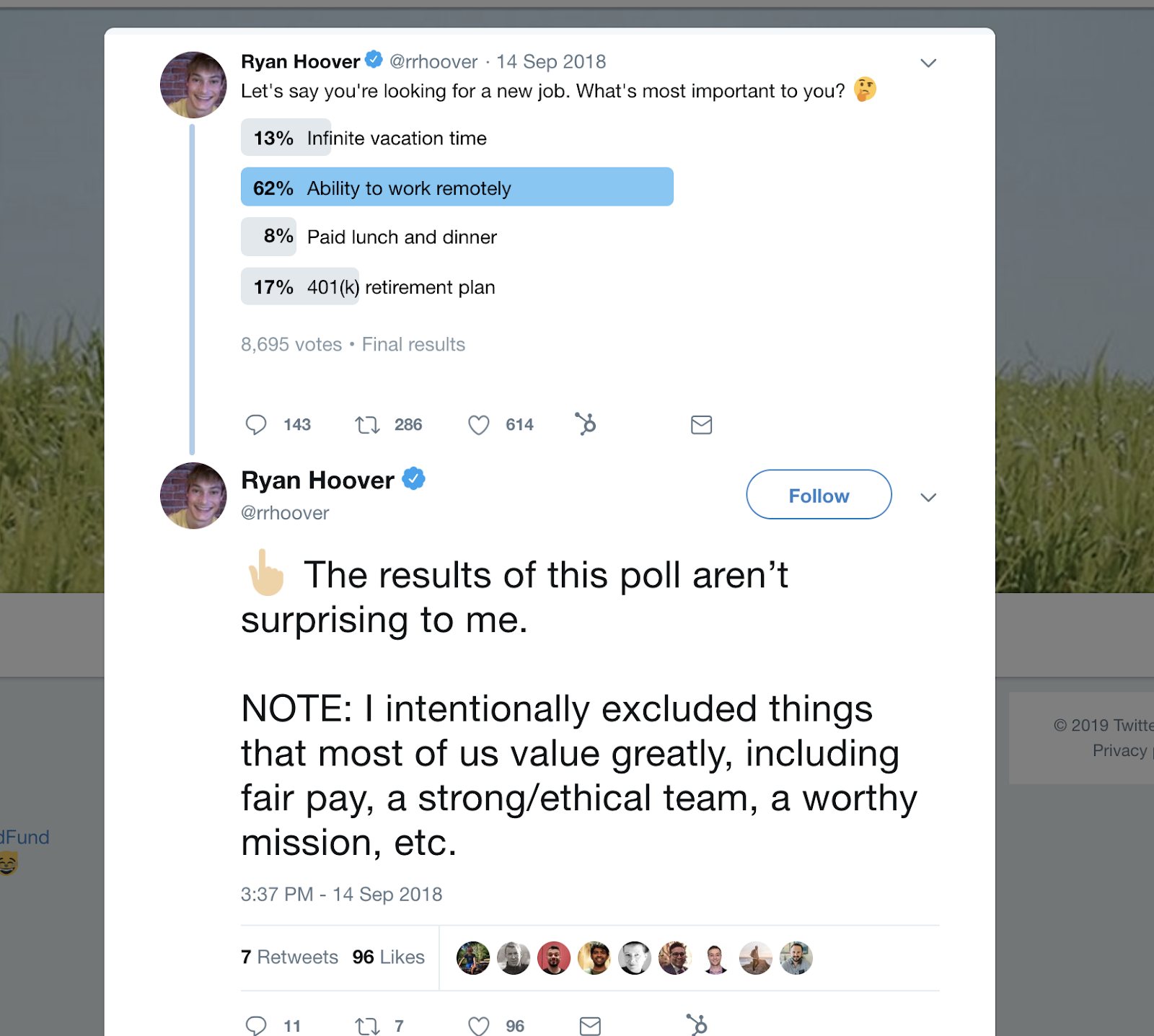
In another case, of 44,008 respondents in a Stack Overflow survey, 35.1% said they work remotely at least a few days per month. 28.8% of respondents work from home more frequently than that. The highest job satisfaction was reported by developers who work completely or almost completely remote.
Still, though, I have to admit, there are some struggles working remote, and they largely stem from productivity challenges.
Connection and Focus: Bridging the Remote Gap
There are, of course, many tools that help employees save time or increase their work output.
For example, if you do any writing or blogging, Wordable helps you upload Google Docs to WordPress in a few clicks. Or Four Sigmatic mushroom coffee could give you a productivity boost in the form of more energy. Just as well, I like to think a good email marketing tool can save you a lot of cumulative time over the long run.
These, however, are general productivity tips and tools. While they help remote workers, they help everyone else, too. Instead, for this article, I’ll focus on remote specific productivity advice.
In my mind, there are two problems that can affect remote workers’ productivity:
- Distraction
- Lack of Connection & “Water Cooler” Effects
In the first case, there are many more potential distractions when you control your own environment and hours.
Of course, there are blatant attacks on productivity, like Netflix, social media, or even cleaning your living room. But even more insidious is the lack of a prototypical work day and an atmosphere that signifies “it’s time to work.”
This is mostly a problem with those who have home offices since a coworking space can replicate the feeling of a separate environment.
But in any case, it takes training and discipline to reduce distractions in a remote work environment.
The second problem is the barrier caused by space, time, and technology. Simply put, for certain collaborative projects, it’s much easier to work together, in person, in the same office space. For me, there’s nothing better than visualizing an idea together with coworkers through a good whiteboarding session.

New technology is helping to bridge this connection gap, but it’s still difficult. It’s best to acknowledge this and plan ahead so your communications can still be effective working in a remote environment.
This article will be split into two sections, following the two problems we outlined here: distraction and connection. I’ll do my best to recommend tools or give very actionable advice where possible (no vague or inspirational statements here).
Reducing Distraction and Improving Focus for Remote Workers
The best thing you can do to reduce distraction is to develop discipline and a routine. This isn’t the easy answer, but no amount of Pomodoro timers and to do list apps will help you if you can’t delineate work and play while working from home.
So for starters, change out of your pajamas and sit at a desk. Even better, work in an environment – be it a desk, separate home office, coffee shop or coworking space – that is separate from where you relax and socialize.
I also like to start my day the same way every morning.
I wake up at 7:00 am, make a coffee (Rutamaya or Four Sigmatic Mushroom Coffee), do a Spanish lesson from 7:30-8:30, do my daily Duolingo lessons, meditate for ~10 minutes, and write in my Daily Stoic journal. Promptly at 9, I begin working, and in the mornings I only work on deep work (I try not to take meetings). After lunch, I hit up a coffee shop or a coworking space and work on email, meetings, and more administrative/managerial/operational tasks.
Past discipline, environment, and routine, there are many tools that can help you get a clear head and focus nowadays. Here are several of my favorites (most of which integrate with Shift, by the way).
Wunderlist
Wunderlist is probably my favorite all around to do list application. I like it because you can create many types of lists and distinguish them by category – work, grocery, personal, etc.

The design is simple enough to launch into immediately, but the tool is also feature-rich, and perfectly suitable as the main project management option for freelancers and small teams. There are even sharing and collaboration options.
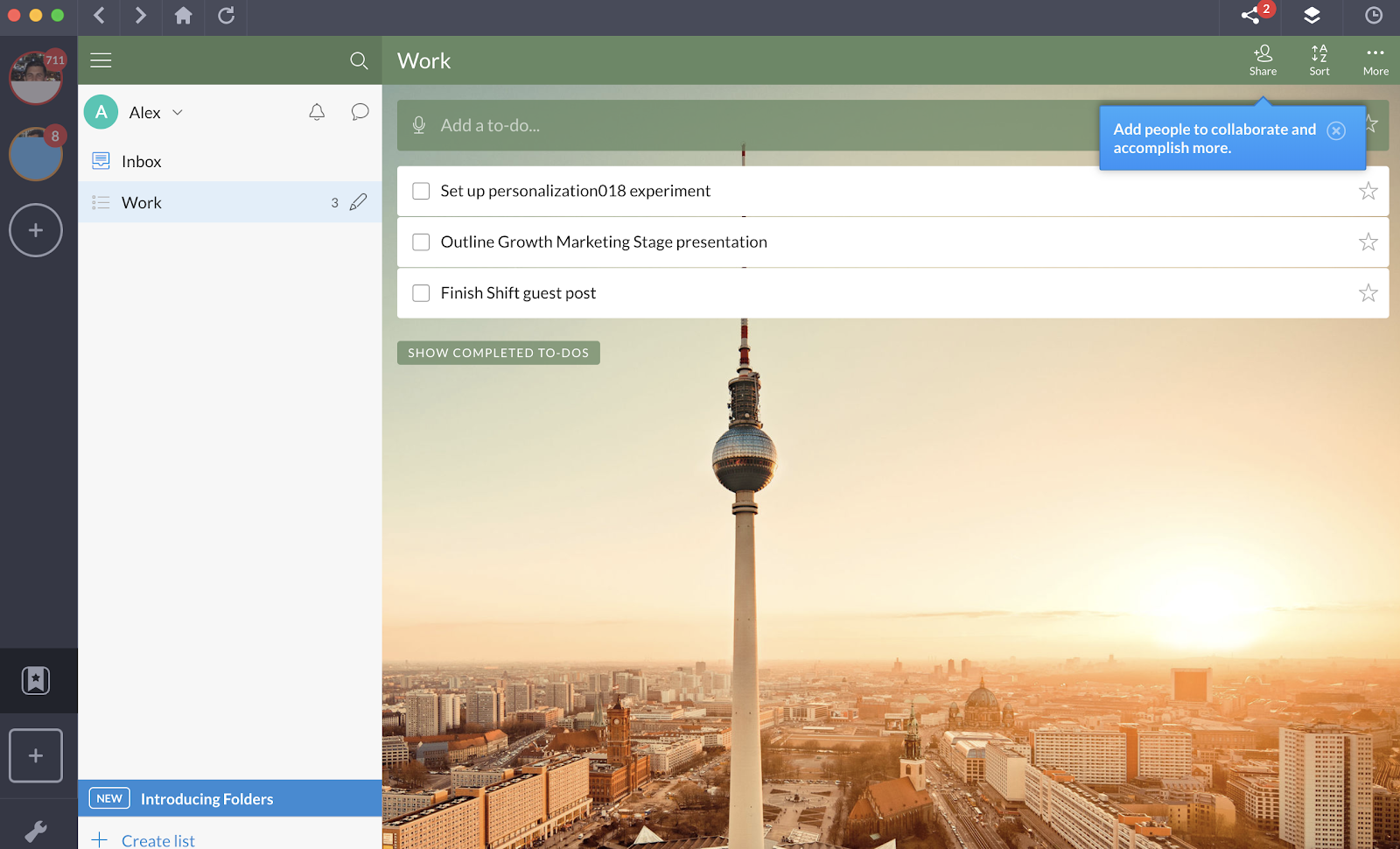
And of course, you can use Wunderlist with Shift as well.
One thing to note is that Microsoft has talked about replacing Wunderlist with Microsoft To Do, though the product marketing is somewhat unclear around these two similar options. I like Wunderlist and haven’t tried To Do, so I can’t comment on the “successor” yet, though you can still use Wunderlist.
Todoist
If you want a test multiple options, Todoist is another option I love for a clean and simple to do list application. The Verge actually ranked this one as their favorite to do list app, and they boast some 15+ million users.
Something I love about Todoist is they have tons of templates and ready to go lists you can just start working with. They partner with other companies, such as Buffer, to create example social media calendar checklists and other templates:
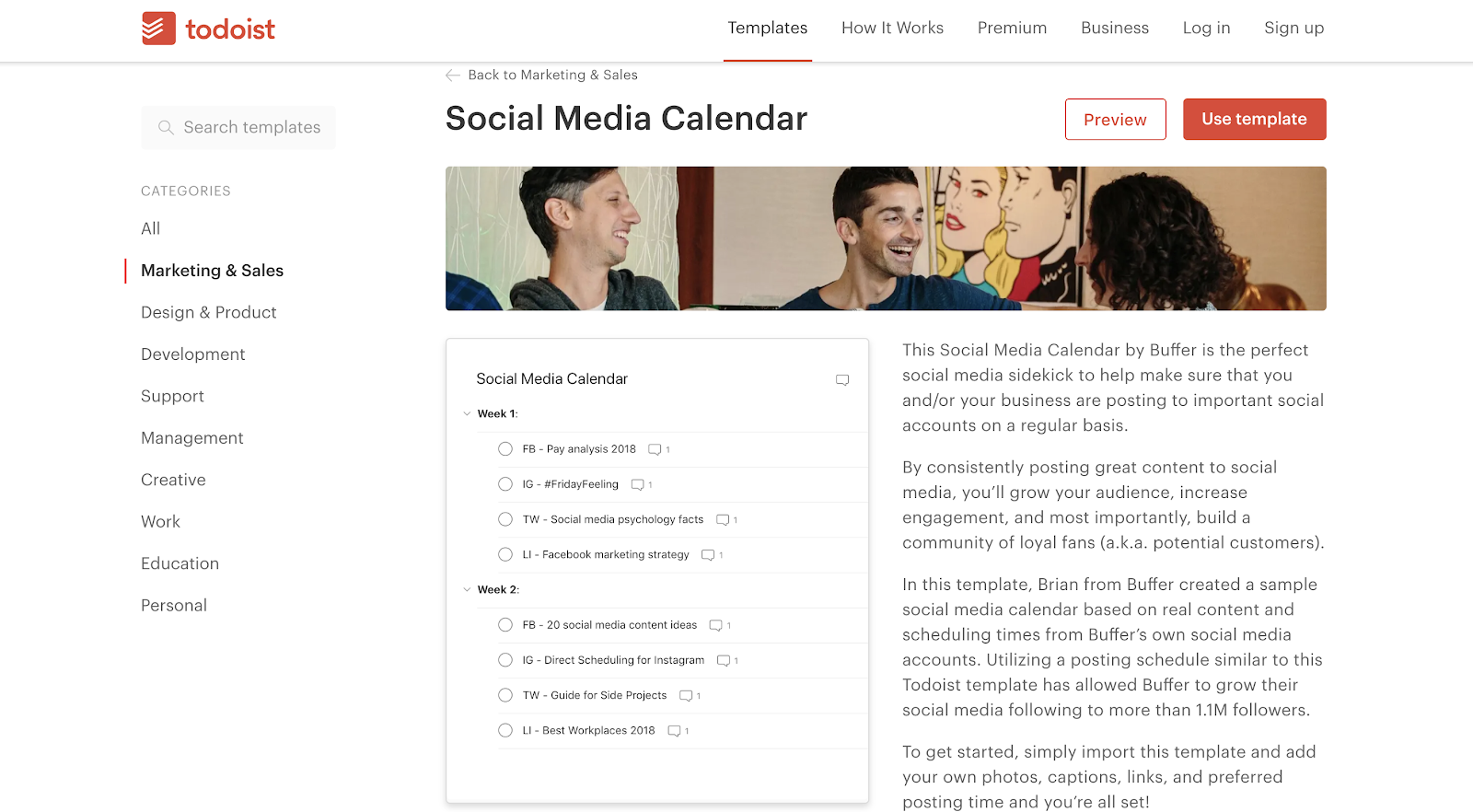
Todoist also works well with Shift.
Boomerang
One of the biggest traps I’ve fallen into since working remotely is the lack of rigidly defined work time. There’s not a real barrier between when you get deep work done when you’re in meetings, when you’re checking emails, etc.
I’ve already talked about trying to build some sort of work routine, especially in the mornings. Another tool that can help you carve out more deep work time is batching your emails. My favorite tool to do this is Boomerang.
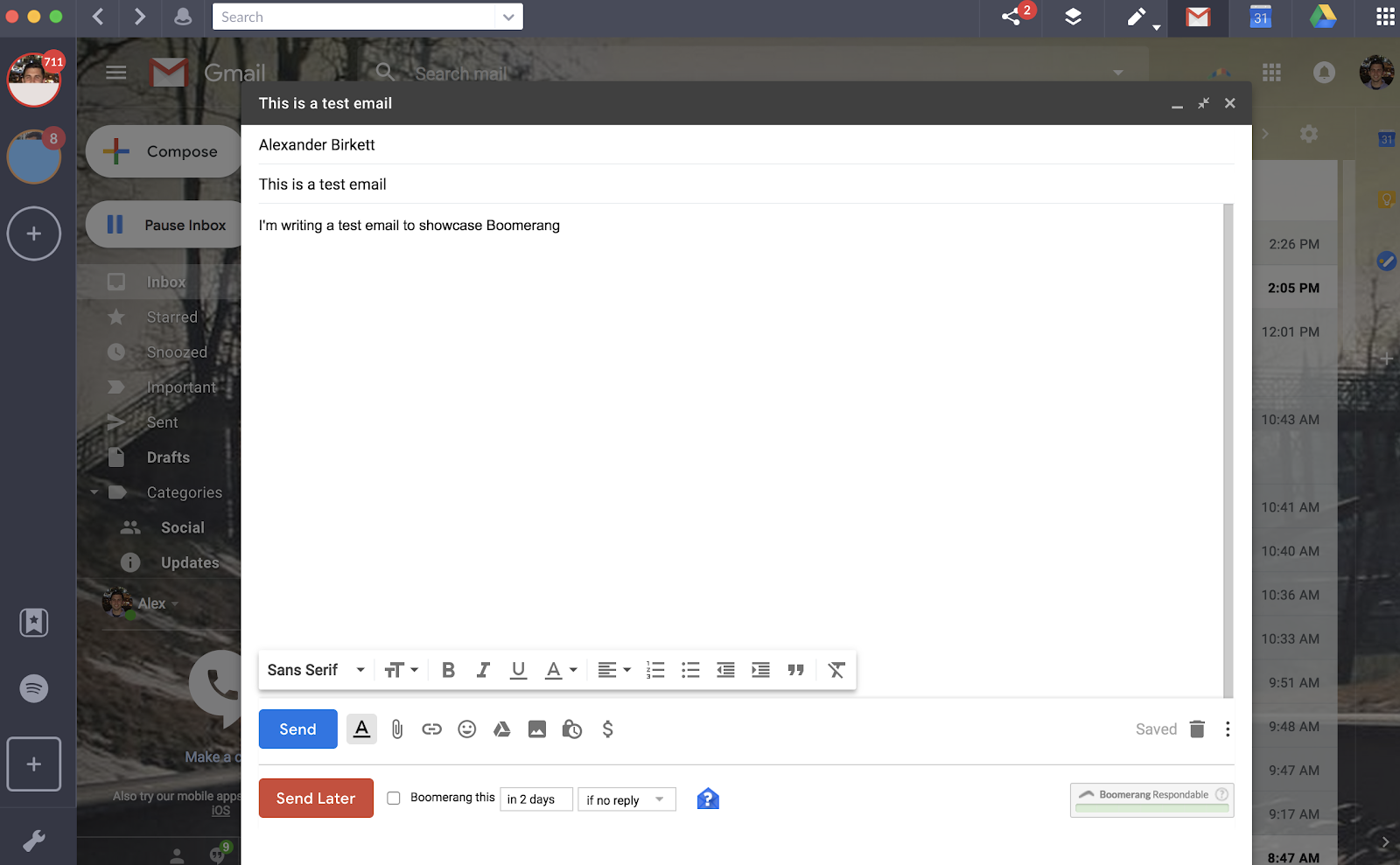
Its basic functionality is that it schedules your emails and allows you to “boomerang” them back to you after a set time period. However, it also has an AI feature that helps you craft respondable emails and allows you to schedule email sequences.
All around, it’s a great email productivity solution. This one also works with Shift.
Coworking spaces + coffee shops
One of my favorite productivity hacks for remote work is to simply change environments.
This may be just me, but I start to feel some cabin fever if I spend all day in the same place. So I like to switch locations every few hours. In the afternoons, sometimes I’ll hit up two or three different coffee shops so I can batch activities and get fresh surroundings. I think there’s something about the limited time frame you give yourself at each place that pushes you to get more done.
Whatever the reason behind it, switching locations and getting out of your ordinary workspace can work wonders for shaking up the mind and inspiring creativity and productivity.
Specific work playlists
I read an article from Ryan Holiday a long time ago where he described his weird trick for productivity. Basically, a plays a song over and over on repeat.
Similarly, Michael Lewis immerses himself in a work playlist:
“I pull down the blinds. I put my headset on and play the same soundtrack of twenty songs over and over and I don’t hear them. It shuts everything else out. So I don’t hear myself as I’m writing and laughing and talking to myself. I’m not even aware I’m making noise. I’m having a physical reaction to a very engaging experience. It is not a detached process.”
So try listening to the same song or playlist on repeat. Crazy? Sounds like it. Effective? Possibly, and it’s cheap and easy to find out.
I do something similar. Whenever I read, I listen to a well-curated playlist of my favorite classical music. When I write, I listen to the same 12-20 skate punk songs (loudly):

Coffee shop laptop battery hack
When you work at a coffee shop or coworking space, try heading there without your laptop charger. This gives you a few hours, max, to get done what you need to get done. You’re racing the clock now.
Nothing like a little time pressure to maximize your productivity. This, actually, is a hack that is mostly only available to those remote workers among us. There are a million chargers available in any office space, so you can’t even delude yourself to thinking you’d have to go without one.
Bridging the Connection Gap: Keeping Remote Workers Engagement and Communicative
The above tips help me get stuff done, but eventually, I find remote work can feel a little empty or hollow. There’s something about the human connection at work that leads to inspiration, fulfillment, and “idea fireworks” – where you start with something in mind and, through a great brainstorm session or conversation, come up with something completely different and better.
I think it’s pretty hard to fully replicate that working remote, but there are many ways I’ve found to basically make up for it.
Quarterly in-person work weeks
Every 2-3 months, I try to go into a HubSpot office. While I’m there, I spend a lot less time working in R or Excel, and a lot less time writing, but I spend much more time getting to know my coworkers. This naturally leads to a lot of brainstorming and strategy work, which I think is very difficult to do when you’re separate from the flagship.
If your company has no HQ or if your team is very small (or it’s just you), it may help to schedule some sort of quarterly coworking with other freelancers or people from other companies.
Remote retreats
The main benefit of working remotely is that it doesn’t matter where you are as long as the work gets done. Therefore, you can probably get away with scheduling a trip with other remote workers, possibly within your own company or possibly with other freelancers or remote people from other companies. This trip can be a sort of “mastermind” where you get work done, let ideas fly, and share what’s working and what’s not working.
I’ve seen these become more and more popular in the last few years, and I’m starting to plan my own as well. The planning and organizing part is somewhat difficult, but if you get together a Slack or Facebook group and a few web forms or polls to decide on the place and dates, you should be able to pull it off.
Industry Meetups
Everyone knows about meetup.com at this point, and certainly, there are great meetups on there. At least to start, you should try to seek out some interesting groups in your industry and start to regularly attend the good ones.
I’ve found, though, that forming your own informal group is even more valuable. For instance, every month (almost every month), a small group of 4-8 regulars and 4-8 new faces in the conversion optimization industry get together and A/B test adult beverages (and sometimes we talk about professional topics as well).
It’s a great way to keep in touch with what’s going on in your industry and feel like you’re part of the local cohort.
Lunch & Coffee
If the biggest benefit of working remotely is the freedom, the biggest responsibility might be that you should bring outside ideas to your company. Because you don’t have the social crutch and benefit of coworkers to hang out with and talk to, it’s important to get out and grab lunch or coffee with other smart people in your area.
I make it a point to regularly grab lunch with several growth and CRO friends in Austin, and I’m also not shy about reaching out to new faces either, especially if it looks like they’re in a similar position or work on similar stuff that I’m working on.
Being remote and networking with other people from other companies gives you a brilliant excuse to become the maverick with a bunch of fresh ideas.
Zoom
Even if it feels unproductive, try to get on video calls from time to time (and not just for big company meetings). It helps to schedule regular Zoom (or Skype or Google Hangouts) hangouts with your direct teammates, even if there isn’t a strongly organized agenda.
I also know a few people who schedule regular Slack chats, just to shoot the shit or catch up on what the other person is doing. Being remote or distributed, it can be easy to forget about the importance of spontaneous conversation and to over-optimize for deep work and solitude.
Zoom works well with Shift, by the way.
Related Article: Zoom Tips: How to Use Zoom Meetings for Remote Video Conferencing
Loom
One of my favorite tools for communication nowadays in Loom. When you’re in an office, you can pull someone over when you’re working on a problem and have them look over your shoulder.
When you’re remote, you have to rely on words only, or maybe a screenshot.
However, with Loom, you can record short videos and screen shares. I find this is absolutely perfect for a few occasions:
- Sharing presentations and strategic ideas
- Troubleshooting technical issues (e.g. Google Analytics)
- Sharing off the cuff or half baked ideas to get quick feedback
I find myself using Loom more and more with time.
Remote whiteboarding solution
To be honest, I haven’t found a great remote whiteboarding solution. Zoom now has a feature that is pretty good, and I’ve used it a few times. Realtimeboard is one of the more popular tools on the market, but I haven’t tried it out yet.
This is an area I think technology could help solve. I’m hoping Zoom continues to pour R&D resources into building out that feature. I like what I’ve seen so far, but it’s quite basic.
Random Slack Channels
Finally, in addition to whatever other productive work communication channels you have (email, Slack, whatever), I think it’s important to open up a few channels that are just for fun or are random.
HubSpot is a big company, so we have tons of niche channels (include one excellent one specifically for remote workers!). But even if you’re a smaller company, I think it helps to have a channel for “random” conversation, and you should definitely separate that from your main work channels (otherwise it would be anarchy).
Encourage fun and open conversation from time to time. It helps build team synchronicity and engagement, which of course, makes a more productive workspace (especially when remote).
Related Article: The Ultimate Guide to Working Remotely with Slack
Conclusion
Remote work is rich with benefits, but it’s still fraught with challenges. Namely, it’s hard to focus with all the distractions, and it’s hard to get the same connection and cohesion that you get from in-person meetings and sessions.
Frankly, remote work is going to require some tradeoffs. You may never be able to fully replicate the social benefits of in office work, but you’ll get additional benefits in terms of your employees’ focus and ability to pull in outside/creative ideas. In addition, you can recruit talented employees more easily when you open up remote work as a possibility.
In any case, it will still require discipline. I’ve learned a ton about remote work since starting it a little over a year ago, and at this point, I’m probably 1.5-2x more productive than I ever was in an office. Still, the connection and social side remain a challenge, so I’m always learning.
Hopefully, some of this list helps cut down your learning curve!
Ten articles before and after
How to Login to Multiple Survey Monkey Accounts
A Quick Guide to Shift Keyboard Shortcuts
New Year, New Goals & 120 New Apps To Help!
Your Guide to Custom Slack Commands
5 Ways to Add GIFs to Your Emails
How to Make the Switch to G Suite
How to Login to Multiple Discord Accounts at Once
